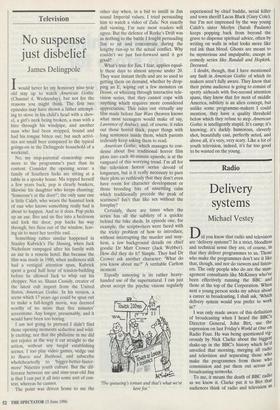Television
No suspense just disbelief
James Dehngpole
Iwould never let my honorary nine-year old stay up to watch American Gothic (Channel 4, Wednesday), but not for the reasons you might think. The first two episodes may have shown a father attempt- ing to stove in his child's head with a shov- el, a girl's neck being broken, a man with a biro through his windpipe, and another man who had been stripped, bound and had his tongue bitten out; but such activi- ties are small beer compared to the typical goings-on in the Delingpole household of a weekend.
No, my step-parental censorship owes more to the programme's pace than its content. Consider the opening scene: a family of Southern hicks are sitting at a table in a spooky house. Ma topped herself a few years back, pop is clearly bonkers, likewise his daughter who keeps chanting: `Someone's at the door!'; the only sane one is little Caleb, who wears the haunted look of one who knows something really bad is about to happen. And so it does. Pop picks up an axe. Bro and sis flee into a bedroom and lock the door, pop hacks his way through, bro flees out of the window, leav- ing sis to meet her terrible end. . . .
Something rather similar happened in Stanley Kubrick's The Shining, when Jack Nicholson rampaged after his family with an axe in a remote hotel. But because the film was made in 1980, when audiences still had a vestigial attention span, Kubrick spent a good half hour of tension-building before he allowed Jack to whip out his chopper. Not so, Shaun Cassidy, creator of the latest cult import from the United States, American Gothic. In his version, a scene which 17 years ago could be spun out to make a full-length movie, was deemed worthy of no more than five minutes' screentime. Any longer, presumably, and it would have been too boring.
I am not going to pretend I didn't find those opening moments seductive and wild- ly exciting; nor that the philistine in me did not rejoice at the way it cut straight to the action, without any turgid establishing scenes. I too play video games, vedge out to Beavis and Butthead, and subscribe wholeheartedly to `bigger-better-faster- more' Nineties youth culture. But the dif- ference between me and nine-year-old Jim is that I can put it all into some sort of con- text, whereas he cannot.
The point was driven home to me the other day when, in a bid to instill in Jim sound Imperial values, I tried persuading him to watch a video of Zulu. Not exactly dull viewing, I'm sure most readers will agree. But the defence of Rorke's Drift was as nothing to the battle I fought persuading Jim to sit and concentrate during the lengthy run-up to the actual conflict. Why couldn't we just fast-forward until it got good?
What's true for Jim, I fear, applies equal- ly these days to almost anyone under 20. They want instant thrills and are so used to getting them on demand, whether by drop- ping an E, wiping out a few monsters on Doom, or whizzing through interactive tele- vision series, that they cannot cope with anything which requires more considered appreciation. This rules out virtually any film made before Star Wars (heaven knows what most teenagers would make of say, Lawrence of Arabia); and, of course, it rules out those horrid thick, paper things with long sentences inside them, which parents tediously keep asking them to read.
American Gothic, which manages to con- dense about five traditional horror film plots into each 40-minute episode, is at the vanguard of this worrying trend. I'm all for the television horror series devoid of longueurs, but is it really necessary to pare their plots so ruthlessly that they don't even have room for character development or those brooding bits of unsettling calm which traditionally precede the peak of scariness? Isn't that like sex without the foreplay?
Certainly, there are times when the series has all the subtlety of a quickie behind the bike sheds. In episode one, for example, the scriptwriters were faced with the tricky problem of how to introduce, without interrupting the murder and may- hem, a few background details on chief goodie Dr Matt Crower (Jack Webber). How did they do it? Simple. They had Dr Crower ask another character: 'What do you know about me?' A veritable Carlton moment.
Equally annoying is its rather heavy- handed use of the supernatural. I can just about accept the psychic visions regularly The queueing's torture and that's what we're here for.' experienced by chief baddie, serial killer and town sheriff Lucas Black (Gary Cole), but I'm not impressed by the way young Caleb's sister Merlyn (Sarah Paulson) keeps popping back from beyond the grave to dispense spiritual advice, often by writing on walls in what looks more like red ink than blood. Ghosts are meant to be mysterious and impalpable, except in comedy series like Randall and Hopkirk, Deceased.
I doubt, though, that I have mentioned any fault in American Gothic of which its makers aren't fully aware. They know that their prime audience is going to consist of spotty airheads with five-second attention spans, they know that for most of middle America, subtlety is an alien concept, but unlike some programme-makers I could mention, they have a quality threshold below which they refuse to step. American Gothic is intelligently stupid. It's camp; it's knowing; it's darkly humorous, cleverly shot, beautifully cast, perfectly acted, and above all, it's very, very scary. Like a lot of youth television, indeed, it's far too good to be wasted on the young.


































































 Previous page
Previous page